The Realm of the Ice Giants
What Exploring These Planets Teaches Us
AMY SIMON is a planetary scientist at NASA’s Goddard Space Flight Center who has studied the atmospheres of the giant planets for 25 years. She has served on the science teams of multiple NASA missions (Galileo, Cassini, OSIRIS-REx, and Lucy) and leads the Hubble Space Telescope’s Outer Planet Atmospheres Legacy program.
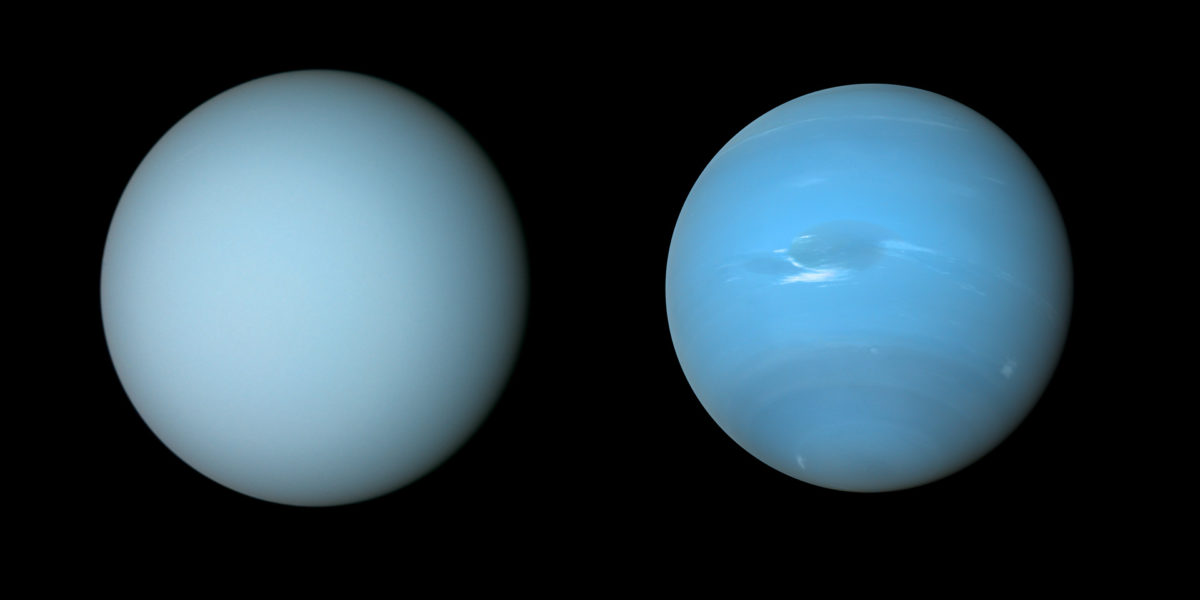
Imagine 2 icy worlds far from the Sun. Their serene, blue atmospheres. Huge, ominous-looking storms. Tantalizing glimpses of moons with exotic, icy terrains. Delicate sets of encircling rings.
Speeding toward its eventual escape from the solar system, Voyager 2 visited Uranus in 1986 and Neptune in 1989. These historic flybys gave us our first detailed views of these intriguing worlds along with the rings and moons that surround them. No other spacecraft have ventured there since. Uranus and Neptune reside in a largely unexplored corner of the Sun’s realm, yet they are members of the most populous planetary mass range (50 to 100 Earth masses) based on our current knowledge of extrasolar systems.
The brief Voyager flybys revealed these 2 worlds to be quite different from Jupiter and Saturn, sometimes called the gas giants. Given their large distances from the Sun, Uranus and Neptune are much colder and have a higher abundance of atmospheric water and other ice-forming molecules, earning them the nickname “ice giants.” Ice giants are mostly water, probably in the form of a supercritical fluid; the visible clouds likely consist of ice crystals with different compositions. Despite their cold temperatures, they still support giant storms, much like Jupiter’s Great Red Spot or Saturn’s large, seasonal outbreaks.
Observing From Earth
With the Voyager flybys long since passed, today we’re stuck with studying the ice giants from the ground. Well-equipped amateur astronomers with larger telescopes can often identify localized storms of bright clouds crossing the planets’ tiny disks. (In 2019, Uranus and Neptune will be best positioned for telescopic viewing in October and September, respectively.)
Planetary scientists primarily study these worlds using large, ground-based telescopes, such as Keck Observatory, Gemini Observatory, and Europe’s Very Large Telescope, all of which use adaptive optics to sharpen the view. The Hubble Space Telescope is also used to track storm and cloud activity over time, and even the Kepler spacecraft observed the ice giants as they passed through its field of view.
Uranus and Neptune have some obvious similarities. Roughly 4 times Earth’s diameter, they are almost identical in size (to within 3 percent), and their deep interiors have comparable rotation rates: 17 and 16 hours, respectively. However, the length of a “day” in their atmospheres varies a lot depending on latitude because both sport high-speed winds up to 400 meters per second (900 miles per hour)—even faster than those on the gas giants.
Both planets appear pale blue. Their blue color arises from the strong absorption of sunlight’s red wavelengths by minor amounts of methane (CH4) in their atmospheres. Neptune’s blue is deeper than Uranus’ blue, either because Uranus has more haze or because Neptune’s atmosphere has another unidentified constituent that absorbs longer wavelength light even more strongly. Both also have complex magnetic fields that are offset from their centers and angled askew, which create asymmetrically shaped magnetospheres. Both have rings and satellite systems with dozens of moons.
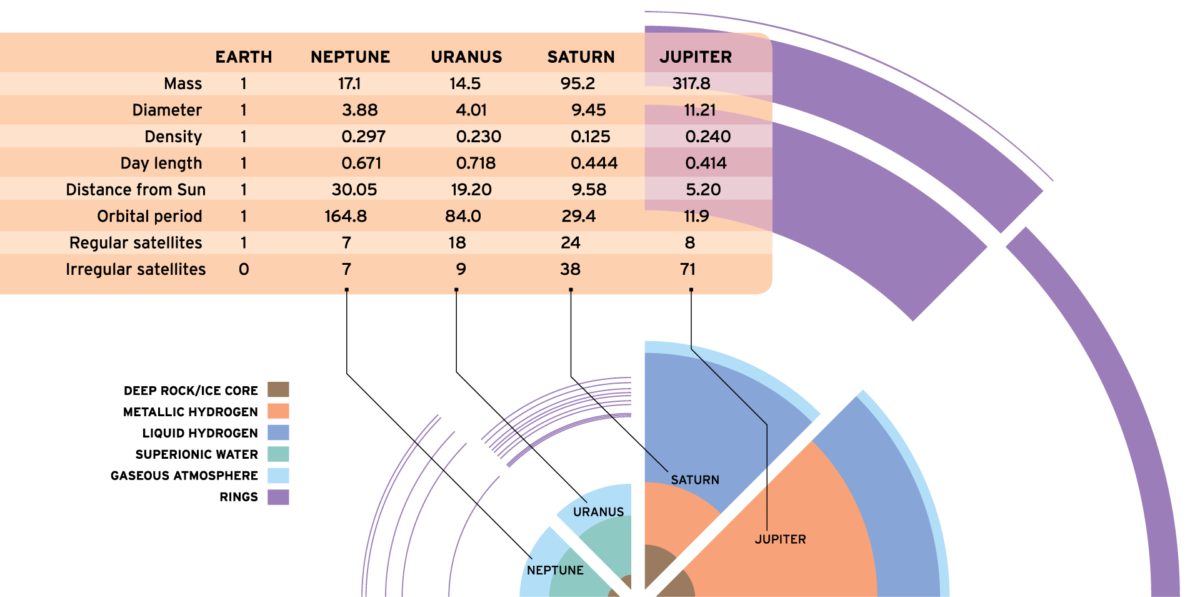
However, as you’ll discover below, the ice giants also differ from each other in significant ways, presenting unique extremes for studying this class of planet.
Uranus
Uranus has the largest obliquity (axial tilt) of any planet, a substantial 98 degrees, so its globe is essentially rolling on its side. Given its distance from the Sun (averaging 19.2 AU), this planet takes 84 years to complete an orbit, leading to very long seasons that keep each pole bathed in continuous sunlight or darkness for decades. Uranus radiates no more energy than it receives from the Sun—it’s the only outer planet without excess internal heat. This may be due to when and how it formed. It may also result from sluggish atmospheric convection in an atmosphere that’s effectively a super cold –220 degrees C (–365 degrees F).
When viewed by Voyager 2, Uranus presented a bland atmosphere, virtually devoid of detail. However, though not as stormy as Neptune’s atmosphere, Uranus’ atmosphere is far from inactive. In recent years, ground-based observations and the Hubble Space Telescope have revealed distinct clouds and storms. A dark spot appeared in 2006, presaging widespread activity associated with the northern spring equinox in 2007. Yearly monitoring by Hubble continues to show small, bright clouds—likely condensations of methane or hydrogen sulfide ice—appearing and disappearing. Most recently, ground-based infrared observations identified hydrogen sulfide gas in the Uranian atmosphere, while none of this gas is seen in the upper atmospheres of Jupiter and Saturn, and researchers had presumed that any hydrogen sulfide must lie deeper down and hidden from view.
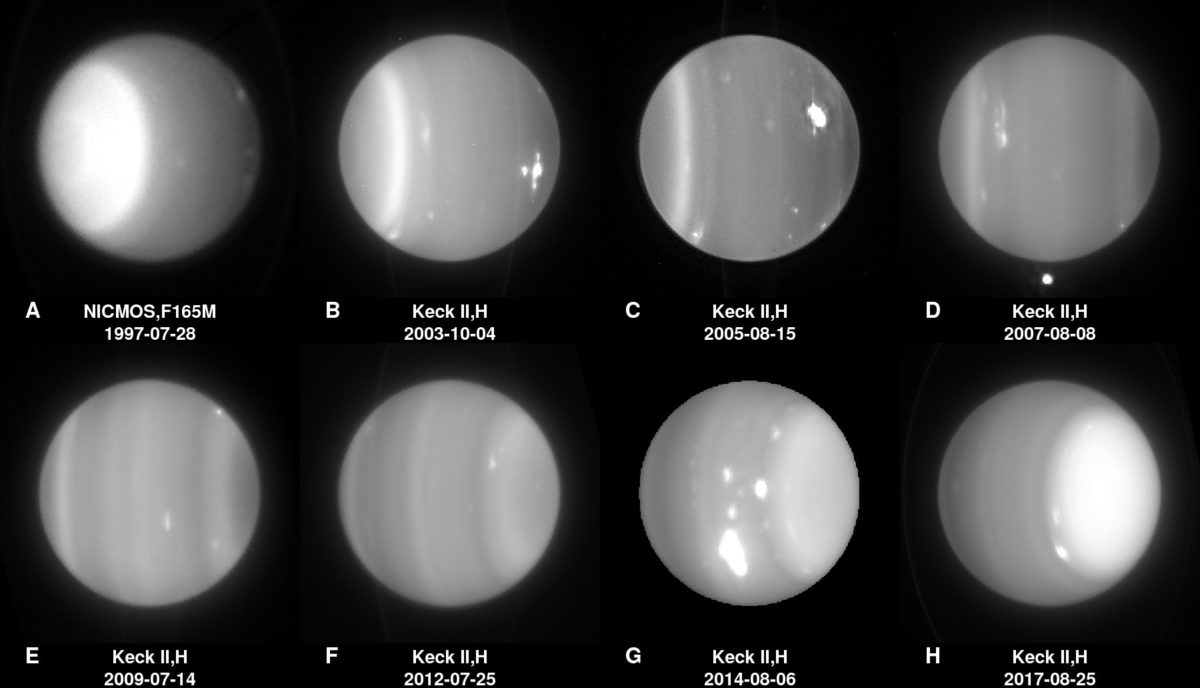
Uranus has many medium-sized moons but no single large one akin to Saturn’s Titan. These companions appear to have formed in place during or after whatever event tilted Uranus onto its side, and they orbit in its equatorial plane. The moons contain slightly more ice than they do rock, with some unknown material darkening their surfaces. They also show the spectral signature of frozen carbon dioxide (“dry ice”). Ariel’s surface has structures that look like flow features, and Umbriel has a bright polar ring, perhaps ice lying exposed on a crater floor. Another small moon, Mab, may be generating a tenuous, blue-toned ring, like Enceladus does for Saturn’s E-ring, though its source currently remains a mystery. Many of the small moons tumble and interact throughout the main Uranus rings, which are much darker and narrower than Saturn’s yet more opaque than Jupiter’s.
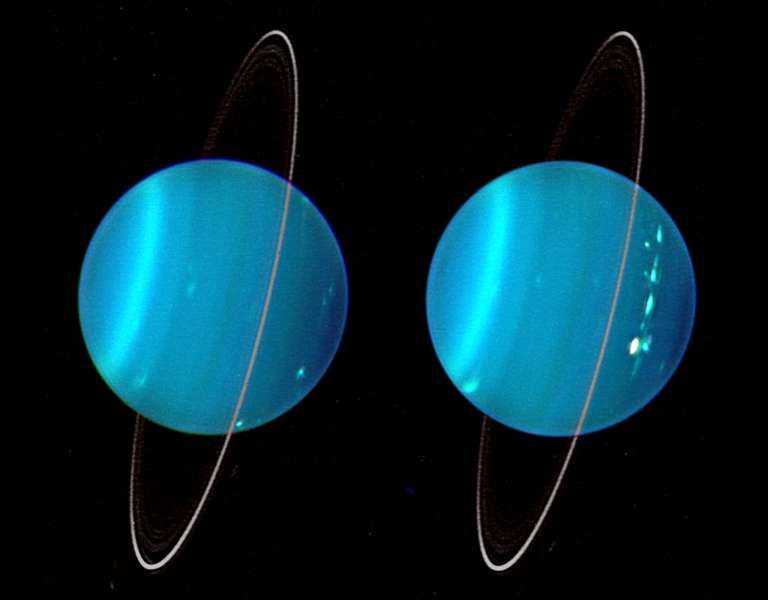
Neptune
Neptune resides 30 AU from the Sun, taking 165 years to complete an orbit. Despite being much farther out than Uranus, its average temperature is similar (–230 degrees C or –380 degrees F), and Neptune’s interior is emitting more than twice the radiation it receives from the Sun. It’s certainly a mystery why Uranus and Neptune differ in this regard. One complication is that the overall reflectivity of Neptune varies with time, absorbing more or less sunlight at a wide range of wavelengths. That might have an effect on its energy balance.
Compared to Uranus’ extreme obliquity, Neptune has a much more reasonable 28-degree tilt, similar to that of Earth, Mars, or Saturn. Voyager 2 showed Neptune to have many bright clouds and storms, including a particularly large anticyclonic storm not then visible from the existing Earth-based facilities. Similar to Jupiter’s Great Red Spot, it was named the Great Dark Spot, but it was apparently no longer present when Hubble first viewed Neptune in 1994.
Since then, several candidate new dark spots have been observed, though none lasted longer than a few years. A small one, discovered in Hubble images in 2015, was accompanied by high, thick, and white clouds easily visible from Earth-based telescopes. Another outbreak of bright storms occurred in 2017, and the most recent 2018 Hubble images show a new dark spot as large as the one imaged by Voyager 2. Unlike storms on Jupiter, Neptune’s large storms are not confined in latitude and can move toward the poles or equator, which likely contributes to their short life spans. Some research suggests that the “weather layer” in Neptune’s atmosphere—and Uranus’ too—may be no more than about 1,000 kilometers (600 miles) deep.
Neptune has at least 14 moons, most of which were spotted by Voyager 2 or by intensive telescopic searches. Its best-known satellite is Triton, which at 2,706 kilometers (1,681 miles) across is 20 percent smaller than Earth’s Moon but 10 percent larger than Pluto. Triton circles Neptune in the retrograde direction, implying that it is a captured dwarf planet, likely taken from the Kuiper belt. Voyager 2 only glimpsed part of Triton, amazing scientists with its views of an intricately patterned, nearly craterless surface and active, geyser-like jets shooting dark material many kilometers above the south pole. Neptune’s rings are also unlike those of any other planet, sometimes appearing in clumps and as partial arcs rather than complete rings. The weak gravity of a small moon, Galatea, may be shepherding the rings into this configuration.
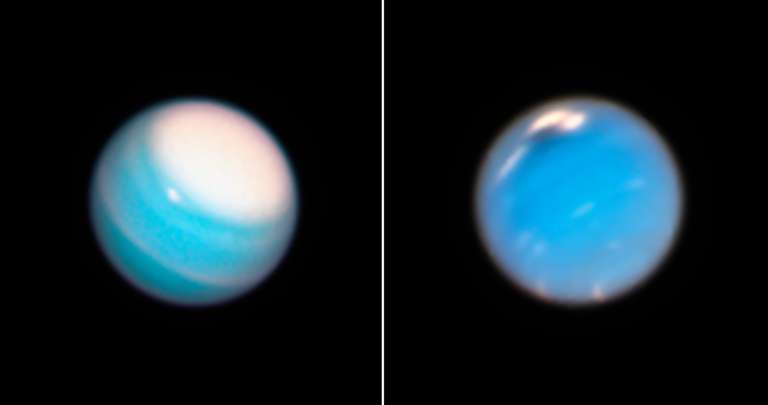
Terra Incognita
There is a long list of things that we don’t know about these local ice giants and what they have to tell us about our solar system. Among the big questions, we seek to understand how the planets formed and why they have their current orbits. For example, some dynamicists suspect that Uranus and Neptune formed much closer to the Sun and then migrated outward due to countless gravitational interactions with small bodies in the primordial solar nebula.
Likewise, we seek to understand the configurations of extrasolar planet systems, many of which look very different from ours, with planets tightly packed close to their stars.
Hubble and ground-based telescopes can help us monitor the changing clouds on Uranus and Neptune, but to figure out which models of solar system formation are closest to the truth, we need to follow up the reconnaissance of Voyager 2 with visits by modern spacecraft.
For example, the nebula from which the Sun and planets formed had compositional gradients that changed as material was swept up or blown off, such that each planet’s unique composition pinpoints when and where it formed. While some constituents can be detected remotely, only an atmospheric probe can measure the noble gases (helium, neon, argon, xenon, and krypton) in each planet’s atmosphere, as these do not chemically react or change over time.
The addition of a satellite system that formed in place (Uranus) and one that was captured (Neptune) further constrains the gravitational interactions that occurred early on among the outer planets. Orbiting spacecraft could scrutinize more regions of these satellites, recording crucial details of geologic features as well as surface composition.
As we strive to understand the hundreds of like-sized extrasolar planets, we need detailed understanding of atmospheric processes on our own planets. Uranus and Neptune provide especially important cases for understanding atmospheric dynamics in cold atmospheres and over a range of seasonal extremes. Do the heat balances of Uranus and Neptune vary over time? Are the emissions from their interiors actually more similar than indicated by Voyager 2? To get answers, we need additional measurements of the reflected (illuminated hemisphere) and emitted (unlit hemisphere) power for each of these planets.
Even better would be detailed measurements of interior structure to understand atmospheric layering and how that affects convection of heat upward from the deep interior. This can be achieved by using orbiters to map the gravity fields close to each planet, as well as by probing deep beneath the cloud tops using radar, microwave sounding, and possibly even Doppler seismology. Atmospheric probes can measure how the temperature, pressure, and winds in these atmospheres change with altitude. This is crucial for knowing how the clouds we observe from Earth fit in global circulation models.
We also seek to understand how ocean worlds—large moons with vast subsurface reservoirs of water—came to exist and how common they may be in our solar system or elsewhere. The discoveries of subsurface oceans on Europa, Ganymede, and Enceladus provide new potential habitats for life. Does Triton also conceal an ocean under its frozen crust? Spacecraft passing near other large moons could map surface features, magnetic field deflections, and maybe even active geysers and plumes, any of which could indicate large liquid reservoirs hidden below the surface.
New missions to Uranus and Neptune can provide timely answers to many of our pressing scientific questions. The ideal scenario involves sending orbiters to both planets that could dispatch instrumented probes to plunge into their atmospheres and obtain critical measurements. If such missions were still active in 2050 (at Uranus) and 2046 (at Neptune), they’d see equinoxes at both planets, with the shifting of seasons and illumination of both poles of both the planets and their moons.
Other bodies could become additional targets of potential ice giant missions. For example, a Neptune orbiter with probe(s) could maximize its science return by also flying past a Centaur asteroid en route and then exploring Triton (a captured Kuiper belt object) after its arrival. A spacecraft heading outward to conduct a Kuiper belt flyby tour could first go past Uranus and deliver an atmospheric probe along the way.
For now, such missions are little more than engineering concepts, but that doesn’t diminish their scientific potential. Let’s go explore the ice giants in our solar system and see what secrets they hold!
What does "Ice" mean?
In the strictest definition, ice is the solid form of water. However, planetary astronomers often use “ice” to refer to the solid form of any condensable molecule. These tend to be highly reflective, form clouds, and (unlike minerals) can readily change between liquid, solid, and gas states at relatively low temperatures. Frozen water and carbon dioxide (“dry ice”) are the most familiar ices on Earth, but methane, ammonia, hydrogen sulfide, and phosphine (PH3) can all freeze in the atmospheres of Uranus and Neptune. (In fact, due to the extremely cold temperatures, most of the clouds we observe there are likely condensations of methane or hydrogen sulfide ice.)
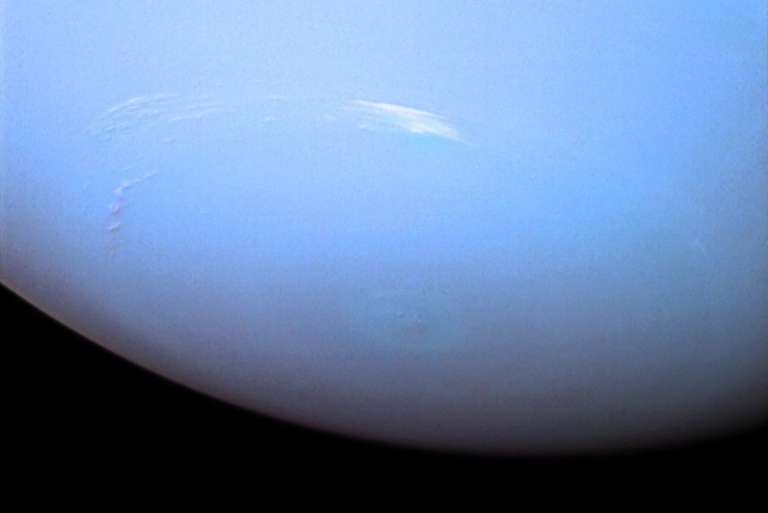
Let’s Go Beyond The Horizon
Every success in space exploration is the result of the community of space enthusiasts, like you, who believe it is important. You can help usher in the next great era of space exploration with your gift today.
Donate TodayThe Planetary Report • March
Help advance space science and exploration! Become a member of The Planetary Society and you'll receive the full PDF and print versions of The Planetary Report.


 Explore Worlds
Explore Worlds Find Life
Find Life Defend Earth
Defend Earth


